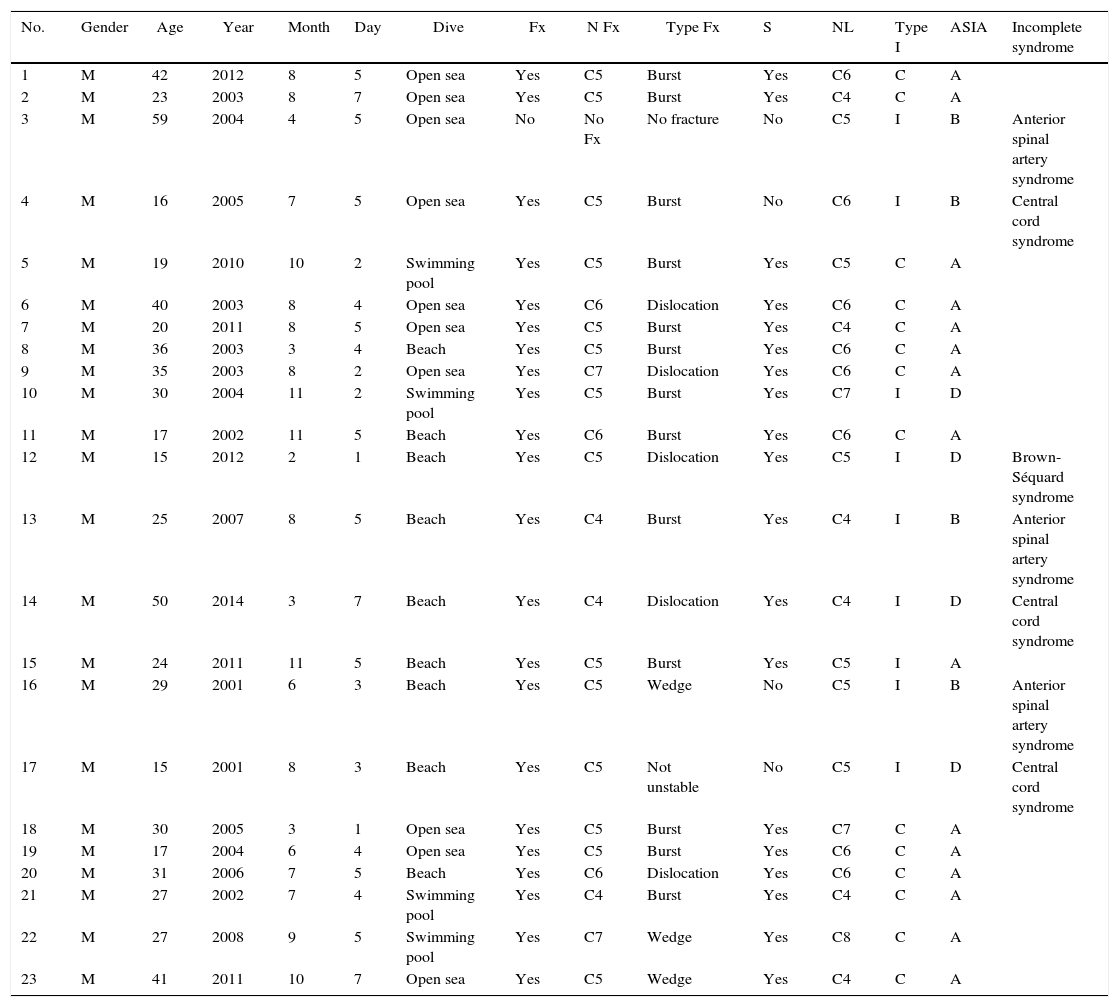Diving accidents is one of the leading causes of spinal cord injury after falls and car accidents. The objective of this study was to determine the epidemiological and clinical characteristics of these patients in our setting to better prevent these injuries.
Material and methodsWe performed a retrospective, descriptive study of patients who have suffered from a traumatic spinal cord injury after a diving accident in the Canary Islands, Spain from 2000 to 2014. These patients were admitted to the Spinal Cord Unit of Hospital Universitario Insular de Gran Canaria.
ResultsOf the 264 patients admitted to our unit for acute traumatic spinal cord injury, 23 (8.7%) cases were due to diving. Grouping the patients into 5years periods, 56% of the injuries occurred in 2000–2005, 17% in 2006–2010 and 26% in 2011–2014. All patients were male, with a mean age of 29years. Approximately 65% were under 30years. A total of 22/23 patients had a fracture and injury most commonly occurred to the C5 vertebra. Burst fractures were the most common. A total of 86% of cases underwent surgery. All the spinal cord injuries were cervical, with C6 being the neurological level most often affected. A total of 65% of spinal cord injuries were complete injuries.
ConclusionsSpinal cord injury secondary to diving accidents is the third leading cause of traumatic spinal cord injury in our setting. It affects young males and the most common clinical presentation is a complete cervical spinal cord injury. Given the irreversible nature of the injury, prevention, aimed mainly at young people, is of great importance.
La zambullida es una de las principales causas de lesión medular, tras las caídas y los accidentes de tráfico. El objetivo de este estudio es conocer las características epidemiológicas y clínicas de estos pacientes en nuestro medio para realizar una mejor prevención.
Material y métodosSe ha realizado un estudio descriptivo retrospectivo de los pacientes que han sufrido una lesión medular de origen traumático tras una zambullida en la comunidad autónoma canaria desde el 2000 hasta el 2014 y que ingresaron en la Unidad de Lesionados Medulares del Hospital Universitario Insular de Gran Canaria.
ResultadosDe los 264 pacientes que ingresaron en nuestra unidad por una lesión medular traumática aguda, 23 (8,7%) fueron por una zambullida. Si se agrupan los pacientes por quinquenios, entre el 2000 y el 2005 se produjeron el 56% de las lesiones, entre el 2006 y el 2010 el 17% y entre el 2011 y el 2014 el 26%. Todos los pacientes eran varones, con una media de edad de 29años. El 65% eran menores de 30años. Veintidós de 23 pacientes sufrieron una fractura vertebral C5—el nivel vertebral más afectado—y la fractura aplastamiento fue la más prevalente. El 86% fueron intervenidos quirúrgicamente. Todas las lesiones medulares fueron cervicales, siendo C6 el nivel neurológico afectado con más frecuencia. El 65% presentaban una lesión medular completa.
ConclusionesLas lesiones medulares tras una zambullida son la tercera causa de lesión medular traumática en nuestro medio. Afecta a varones jóvenes, y la presentación clínica más frecuente es una lesión medular cervical completa. Dado el carácter irreversible de la lesión, es de gran importancia la prevención, dirigida principalmente a la población juvenil.
Article

If it is the first time you have accessed you can obtain your credentials by contacting Elsevier Spain in suscripciones@elsevier.com or by calling our Customer Service at902 88 87 40 if you are calling from Spain or at +34 932 418 800 (from 9 to 18h., GMT + 1) if you are calling outside of Spain.
If you already have your login data, please click here .
If you have forgotten your password you can you can recover it by clicking here and selecting the option ¿I have forgotten my password¿.








